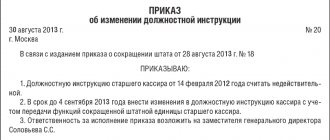Oral or written order?
Some managers prefer to give orders to subordinates orally : from their point of view, this saves time and eliminates additional paperwork. However, this option is not the best solution.
For example, there are cases when an employee carries out orders from his superiors inappropriately or completely ignores them. In such a situation, it will be impossible to bring him to disciplinary action for failure to comply with an oral order.
If you draw up the document in writing , such difficulties (and many others) can be avoided.
That is why experts strongly recommend that all key working moments in terms of administrative activities be formalized in writing: orders or instructions.
Approval through external bodies
There are companies whose documents must be approved by higher authorities. This category includes organizations that enjoy any benefits.
Also, in this situation, a third option is available. What is it? Formation of a letter is allowed. The letter is written according to the established template. First, the document itself is generated, which is subject to approval.
We suggest you familiarize yourself with How to correctly draw up an order about responsible persons
The paper is certified by the head of the company. After which a letter is generated in which a request for approval is expressed. The letter is sent or couriered to the address of the organization that must approve the paper.
After approval, approval occurs, which is notified by means of a return letter. The response letter contains information about approval or indicates the reasons why approval was refused.
When a document thus approved is transferred to the archive, a covering letter is sent along with a sample paper. The letter is an attachment to the agreed paper.
https://www.youtube.com/watch?v=8mi_H-tzNBo
When coordinating a document with several organizations, approval forms are entered at the same level. At the same time, the approval dates indicated in the stamps may differ.
What is the difference between an order and an order?
Directions and orders are somewhat similar to each other: they have approximately the same structure, purpose, etc. However, there are differences between them:
- Area of influence. The main difference between an order and an order is that an order regulates legal relations and the main activities of the company, while an order regulates operational issues.
- Validity. In most cases, the order concerns some local issues, a small number of employees, and is valid for a strictly limited and fairly short period: until it is implemented. Orders have a longer validity period and are often subject to specific changes, while directives are usually simply reissued.
Order or order?
Often these types of documents are combined, believing that an order and an order are one and the same thing. In practice, this often happens, but it is important to understand that:
- the order is issued only on behalf of the director of the entire enterprise;
- orders are issued by the heads of branches and separate divisions of the company.
Also, orders can be signed by shop heads, department managers, etc. Therefore, signing an order is the exclusive authority of the director, and other management employees can only issue orders. At the same time, the director almost always signs the order only in person, but another employee who is officially authorized to do so (has a valid power of attorney) also has this right.
Who has the right to write an order?
An order can only come from the director of the enterprise (or his representative acting on the basis of a power of attorney), and the order can be written by heads of structural divisions and branches, heads of departments, etc., that is, all those persons whose job description specifies this function in the form of a right.
It is important that the employee issuing orders has an idea of how to correctly draw up and execute a document, knows the basics of labor and civil legislation, as well as the internal regulations of the organization - these are the documents that should be referred to when drawing up the document.
Is it necessary to approve job descriptions by order?
Important! The employer independently decides in what order to draw up job descriptions (hereinafter - DI) and make changes to them (see letter of Rostrud dated October 31, 2007 No. 4412-6).
You can find more complete information on the topic in ConsultantPlus. Full and free access to the system for 2 days.
Typically, the rules for registration and approval of DI are determined by a special regulation on DI. Thus, the regulation may stipulate that in order to approve the DI, it is necessary to issue an appropriate order. You can learn more about this from the article at the link: Sample order on the development of job descriptions. In general, to approve a DI, a special mark (approval stamp) on the first page may be sufficient, if this is the procedure provided for by the internal documentation and document flow rules of the organization.
What to pay attention to when drawing up an order
Today there is no single unified sample order, so enterprises and organizations have every right to write it in any form or according to the standard template in force at the enterprise. At the same time, when drawing up a document, it is important to adhere to certain office work standards relating to administrative documentation. In particular:
- The order must be
- assign a number,
- set the date of its creation,
- write the name of the organization.
- Further in the document you need to indicate
- justification or basis for its formation,
- designate the employee or group of employees in respect of whom the order is issued (indicating their positions, names and patronymics),
- the tasks they face,
- deadlines for their resolution.
- It is also necessary to appoint a person responsible for the execution of the order (the author of the document may reserve this right).
If any additional papers are attached to the form, their presence should be noted in the text as a separate paragraph.
What nuances should be taken into account when shaping the neck?
The document approval stamp is located in the upper right corner of the title or first page of the document and consists of the following parts:
- the words “I approve” if the document is approved by an official;
- the name of his position;
- personal signature of the official;
- signature decryption;
- date of document approval.
I APPROVED
General Director of Olimp LLC
Golubev T.I. Golubev
07.11.2016
The stamp must be applied to the upper right corner of the first page of the document. This rule is spelled out in GOST. The form is applied once and is not duplicated on subsequent pages.
The vulture is on the main page. The presence of a date in the form seems to be an indispensable condition for its formation. The date must be factual and current.
In this case, the date of formation of the document is considered to be the last approval. According to the last date, the paper is given legal effect.
Main nuances in the execution of an order
The law does not impose any requirements both on the content of the order and on its execution, so it can be written on an ordinary A4 sheet or on the company’s letterhead. The text can be typed on a computer or written by hand (with a ballpoint pen of any dark color, but not with a pencil).
Only one point must be strictly observed: the document must be signed by the head of the organization or a person authorized to endorse such papers.
At the same time, there is no strict need to stamp it: this should be done only when the norm for the use of stamped products is enshrined in the local legal acts of the enterprise.
The management's order, executed in writing, must be registered in the internal documents register.
Uppercase or lowercase letters?
The word “Approve” (as well as “Approved”, “Approved”, “Approved”) can be typed in both uppercase (capital) and lowercase letters. The organization itself prescribes this procedure in its office management instructions. In GOST R 6.30-2003, these words are typed in capital letters.
Please note: the date of approval of the document will be considered the date of the document.
What is shown in the document
The document itself does not have a unified form, but it must contain the following:
- logo and its full name;
- Contact details;
- Bank details;
- title;
- date when the order was drawn up;
- the city where the document was drawn up;
- registration number;
- the phrase is written - “In order to optimize the paperwork process and ensure uniformity in registration ... (name of organization) I ORDER”;
- text;
- director's signature and its transcript.
The text itself should contain approximately the following wording:
- Approve and put into effect from .. to .. a general form for letters, orders of main activities, memos, and for other types of documents.
- Documents...(name of organization) must be prepared only on the forms approved by clause 1 of this order. The use of other forms is not permitted.
- The secretary-clerk shall not accept for approval, signing and approval by officials of ... (name of organization) draft documents prepared on forms other than those approved by paragraph 1 of this order.
- I leave control over the execution of this order (to myself or another employee).
Problem statement available
An order from the general director is a document-message sent to employees and containing any instructions to them. The latter, by the way, can concern both operational work related to the management of an enterprise, as well as longer-term or highly specialized goals. Taking into account the formulation and urgency of the put forward order, the following types of this document are distinguished:
- oral
- telephone message
- writing
Written form of order
If it is not so difficult to understand the first types of orders, then questions regarding the written format of the document often arise, which are discussed in detail below.
Let us note that a written order from the general director is necessary in any case when the essence of the goals set to employees is quite significant and significant for the organization. Given this nuance, when drawing up such a paper, it is simply unacceptable to define the task in an indefinite, vague and imprecise manner. It is important to understand that the achievement of the goals specified in it will largely depend on how employees perceive the order.
The general director can influence the recipients of orders as effectively as possible in a simple way, namely, by competently setting a task or a set of tasks. To designate goals in a document in this way, you must:
- First, decide for how long or until what results the task will be set. This indicator is extremely important to mention in the order.
- Secondly, it is clear and accessible to define the task, as well as the actions, the implementation of which by employees guarantees the achievement of the set goals.
- Thirdly, in the part of the order where the formulation of a specific task is considered, it is necessary to make references to the internal regulations of the enterprise, explaining to the organization’s employees why they must achieve their goals.
What documents require an approval stamp?
State regulations do not contain a list of documents that must be stamped with approval. Its presence on a particular type of document is determined by its content and meaning. The employer has the right to compile such a list independently, establishing the mandatory presence of this detail in the Instructions or Regulations on office work. The list must be compiled taking into account industry standards and requirements.
Thus, the document approval stamp is usually affixed to the following types of documentation:
- nomenclature of cases used in the organization;
- instructional materials, including job descriptions, instructions on labor protection and safety, for carrying out any work;
- reports, including on R&D, equipment testing, business trips, production activities;
- plans and programs for carrying out work, including those of collegial bodies, as well as for individual employees and departments;
- local regulations: provisions regulating various production processes and labor relations, taking into account the specifics of the enterprise’s activities;
- staffing table, structure of the organization, its staffing levels and amendments made to them;
- tariffs, prices and standards applied at the enterprise, including the consumption of raw materials, components and materials;
- cost estimates;
- unified forms of documents developed and used at the enterprise;
- lists;
- regulations;
- assignments for the production of any work;
- acts, including inspections and audits, liquidation, examinations, write-offs.
Approval of a document by an authorized official is a confirmation of the legitimacy of this document and the assignment of legal status to it.
Which documents do not require an approval stamp?
Many documents included in the organization’s document flow system do not have and, accordingly, do not require confirmation of their legal status. The question of which document does not have an approval stamp is also resolved taking into account common sense - there is no need to approve notices and notifications, memos and letters, information materials .
The document is not approved even if it is of an administrative nature. Orders and instructions are signed by senior officials of the organization, so their signature is sufficient for such a document to be recognized as legitimate.





